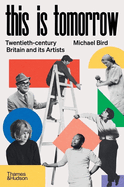
For Michael Bird (Artists' Letters: Leonardo da Vinci to David Hockney), art is inextricable from its social and political context, and 20th-century Britain had a lot of that: multiple wars, austerity and a smorgasbord of clashing intellectual and philosophical beliefs. Bird's authoritative survey, This Is Tomorrow: Twentieth-Century Britain and Its Artists, is thoroughly and engagingly preoccupied with the "nature of art's potential contribution to the cause of social progress." It's safe to say it's a view of art that wasn't shared by all of 20th-century Britain--or all of 20th century anywhere.
This Is Tomorrow actually begins in 1878 with the libel trial that ensued in London after the critic John Ruskin accused the American expatriate painter James Abbott McNeill Whistler of making art that amounted to "flinging a pot of paint in the public's face." Tension of this sort, between the old guard and the newcomer flaunting fresh ideas, was a mainstay in the 100 years of art-making that followed--and, of course, it continues today.
Some British and Britain-based artists rise, cream-like, to the top in Bird's telling; among the best known (at least to American readers) are Whistler, Charles Rennie Mackintosh, Henry Moore, Lucian Freud, David Hockney, Yoko Ono and Damien Hirst, figurehead of the notoriety-courting Young British Artists, who capped off the century. This Is Tomorrow's black-and-white photos, approximately 60 of them, and its 18 color plates prove that while 20th-century Britain may have been a destabilized time and place, it had much to be proud of. --Nell Beram, author and freelance writer

